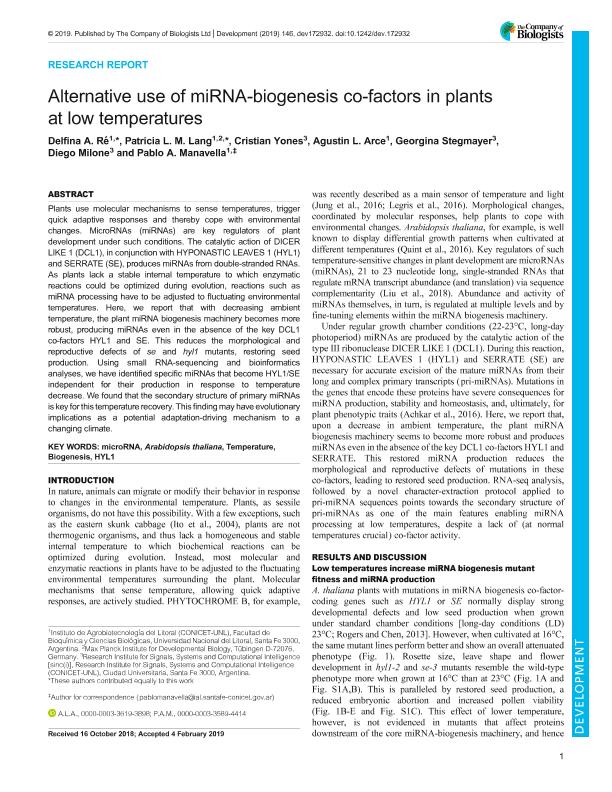Artículo
Alternative usage of miRNA-biogenesis co-factors in plants at low temperatures
Ré, Delfina Adela ; Lang, Patricia L. M.; Yones, Cristian Ariel
; Lang, Patricia L. M.; Yones, Cristian Ariel ; Arce, Agustín Lucas
; Arce, Agustín Lucas ; Stegmayer, Georgina
; Stegmayer, Georgina ; Milone, Diego Humberto
; Milone, Diego Humberto ; Manavella, Pablo Andrés
; Manavella, Pablo Andrés
 ; Lang, Patricia L. M.; Yones, Cristian Ariel
; Lang, Patricia L. M.; Yones, Cristian Ariel ; Arce, Agustín Lucas
; Arce, Agustín Lucas ; Stegmayer, Georgina
; Stegmayer, Georgina ; Milone, Diego Humberto
; Milone, Diego Humberto ; Manavella, Pablo Andrés
; Manavella, Pablo Andrés
Fecha de publicación:
03/2019
Editorial:
Company of Biologists
Revista:
Development
ISSN:
0950-1991
Idioma:
Inglés
Tipo de recurso:
Artículo publicado
Clasificación temática:
Resumen
Plants use molecular mechanisms to sense temperatures, trigger quick adaptive responses and thereby cope with environmental changes. MicroRNAs (miRNAs) are key regulators of plant development under such conditions. The catalytic action of DICER LIKE 1 (DCL1), in conjunction with HYPONASTIC LEAVES 1 (HYL1) and SERRATE (SE), produces miRNAs from double-stranded RNAs. As plants lack a stable internal temperature to which enzymatic reactions could be optimized during evolution, reactions such as miRNA processing have to be adjusted to fluctuating environmental temperatures. Here, we report that with decreasing ambient temperature, the plant miRNA biogenesis machinery becomes more robust, producing miRNAs even in the absence of the key DCL1 co-factors HYL1 and SE. This reduces the morphological and reproductive defects of se and hyl1 mutants, restoring seed production. Using small RNA-sequencing and bioinformatics analyses, we have identified specific miRNAs that become HYL1/SE independent for their production in response to temperature decrease. We found that the secondary structure of primary miRNAs is key for this temperature recovery. This finding may have evolutionary implications as a potential adaptation-driving mechanism to a changing climate.
Palabras clave:
MICRORNA
,
TEMPERATURE
,
ARABIDOPSIS THALIANA
,
HYL1
Archivos asociados
Licencia
Identificadores
Colecciones
Articulos(IAL)
Articulos de INSTITUTO DE AGROBIOTECNOLOGIA DEL LITORAL
Articulos de INSTITUTO DE AGROBIOTECNOLOGIA DEL LITORAL
Articulos(SINC(I))
Articulos de INST. DE INVESTIGACION EN SEÑALES, SISTEMAS E INTELIGENCIA COMPUTACIONAL
Articulos de INST. DE INVESTIGACION EN SEÑALES, SISTEMAS E INTELIGENCIA COMPUTACIONAL
Citación
Ré, Delfina Adela; Lang, Patricia L. M.; Yones, Cristian Ariel; Arce, Agustín Lucas; Stegmayer, Georgina; et al.; Alternative usage of miRNA-biogenesis co-factors in plants at low temperatures; Company of Biologists; Development; 146; 5; 3-2019; 1-7
Compartir
Altmétricas



